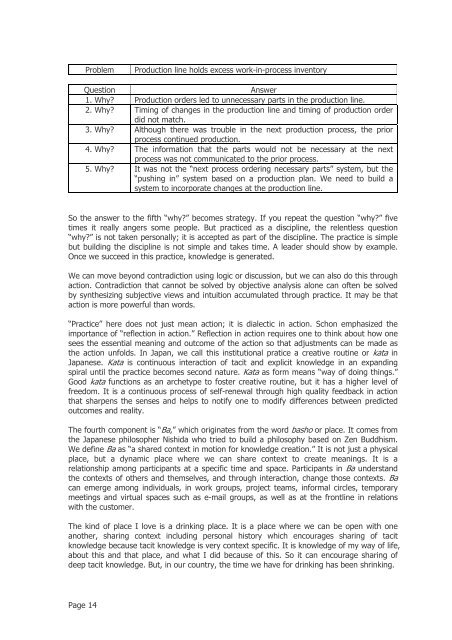Knowledge Management: From Brain to Business (PDF 5.5 - Asian ...
Knowledge Management: From Brain to Business (PDF 5.5 - Asian ...
Knowledge Management: From Brain to Business (PDF 5.5 - Asian ...
Create successful ePaper yourself
Turn your PDF publications into a flip-book with our unique Google optimized e-Paper software.
Page 14<br />
Problem Production line holds excess work-in-process inven<strong>to</strong>ry<br />
Question Answer<br />
1. Why? Production orders led <strong>to</strong> unnecessary parts in the production line.<br />
2. Why? Timing of changes in the production line and timing of production order<br />
did not match.<br />
3. Why? Although there was trouble in the next production process, the prior<br />
process continued production.<br />
4. Why? The information that the parts would not be necessary at the next<br />
process was not communicated <strong>to</strong> the prior process.<br />
5. Why? It was not the “next process ordering necessary parts” system, but the<br />
“pushing in” system based on a production plan. We need <strong>to</strong> build a<br />
system <strong>to</strong> incorporate changes at the production line.<br />
So the answer <strong>to</strong> the fifth “why?” becomes strategy. If you repeat the question “why?” five<br />
times it really angers some people. But practiced as a discipline, the relentless question<br />
“why?” is not taken personally; it is accepted as part of the discipline. The practice is simple<br />
but building the discipline is not simple and takes time. A leader should show by example.<br />
Once we succeed in this practice, knowledge is generated.<br />
We can move beyond contradiction using logic or discussion, but we can also do this through<br />
action. Contradiction that cannot be solved by objective analysis alone can often be solved<br />
by synthesizing subjective views and intuition accumulated through practice. It may be that<br />
action is more powerful than words.<br />
“Practice” here does not just mean action; it is dialectic in action. Schon emphasized the<br />
importance of “reflection in action.” Reflection in action requires one <strong>to</strong> think about how one<br />
sees the essential meaning and outcome of the action so that adjustments can be made as<br />
the action unfolds. In Japan, we call this institutional pratice a creative routine or kata in<br />
Japanese. Kata is continuous interaction of tacit and explicit knowledge in an expanding<br />
spiral until the practice becomes second nature. Kata as form means “way of doing things.”<br />
Good kata functions as an archetype <strong>to</strong> foster creative routine, but it has a higher level of<br />
freedom. It is a continuous process of self-renewal through high quality feedback in action<br />
that sharpens the senses and helps <strong>to</strong> notify one <strong>to</strong> modify differences between predicted<br />
outcomes and reality.<br />
The fourth component is “Ba,” which originates from the word basho or place. It comes from<br />
the Japanese philosopher Nishida who tried <strong>to</strong> build a philosophy based on Zen Buddhism.<br />
We define Ba as “a shared context in motion for knowledge creation.” It is not just a physical<br />
place, but a dynamic place where we can share context <strong>to</strong> create meanings. It is a<br />
relationship among participants at a specific time and space. Participants in Ba understand<br />
the contexts of others and themselves, and through interaction, change those contexts. Ba<br />
can emerge among individuals, in work groups, project teams, informal circles, temporary<br />
meetings and virtual spaces such as e-mail groups, as well as at the frontline in relations<br />
with the cus<strong>to</strong>mer.<br />
The kind of place I love is a drinking place. It is a place where we can be open with one<br />
another, sharing context including personal his<strong>to</strong>ry which encourages sharing of tacit<br />
knowledge because tacit knowledge is very context specific. It is knowledge of my way of life,<br />
about this and that place, and what I did because of this. So it can encourage sharing of<br />
deep tacit knowledge. But, in our country, the time we have for drinking has been shrinking.
















